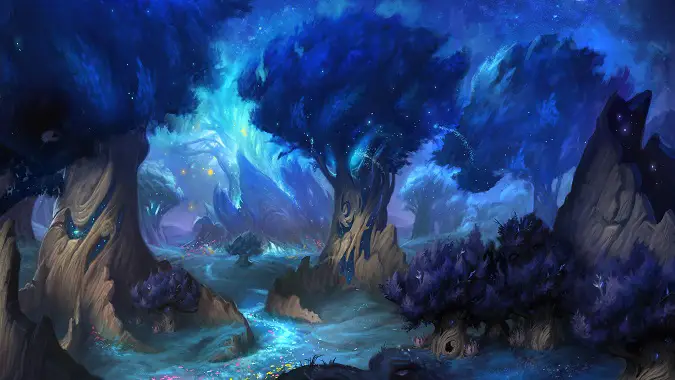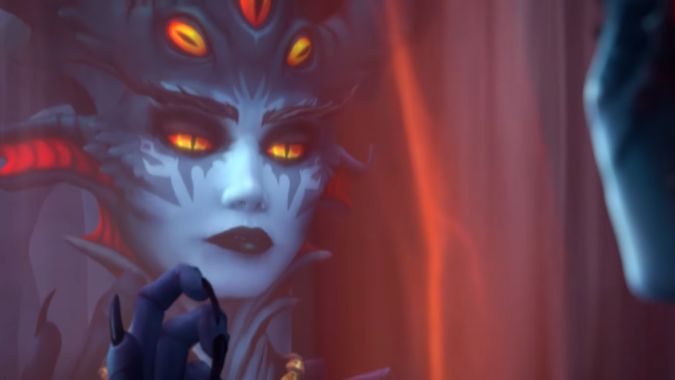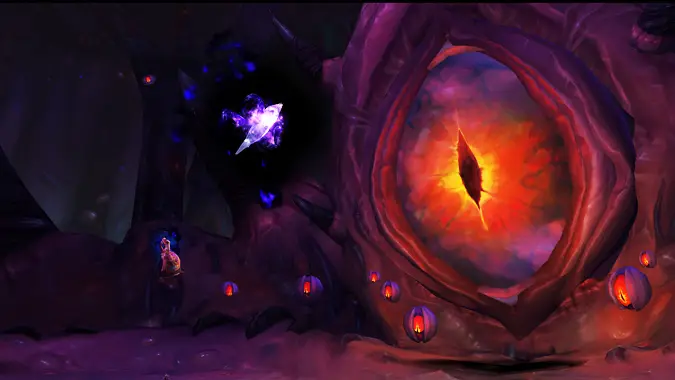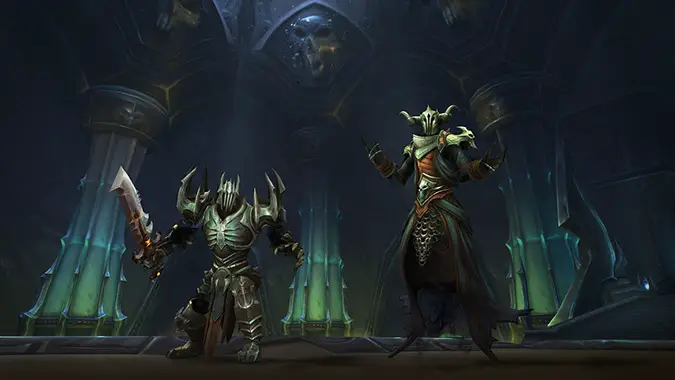Lead Narrative Designer Steve Danuser addresses concerns with Battle for Azeroth’s story and how the team is learning from them for Shadowlands

There is very little I enjoy more than an in-depth study of World of Warcraft and its narrative. Battle for Azeroth has been a fascinating case study in how a game’s story can simultaneously impress and upset me — it’s entirely possible I just wasn’t emotionally ready for the sheer devastation we’ve seen as the Fourth War unfolded, and watching as we go into Shadowlands without a resolution to the traumatic events of that conflict has at times felt disconcerting. So, I was interested when I saw that Steve Danuser had done an interview with Windows Central talking about how Blizzard designs the narrative for WoW, how some of the effects of this expansion are planned to be resolved later, and how Azshara and N’Zoth were always planned to appear in Battle from the beginning.
It’s no secret that I respect Steve greatly — he’s got a legacy of story and game development that includes EverQuest Next and one of my favorite games of all time, Kingdoms of Amalur: Reckoning. This doesn’t mean I always agree with him, but I find his commentary on how Blizzard approaches the work of designing an unfolding story not just for an expansion, but for the game past an expansion, to be both insightful and illuminating. Whether you like the story of Battle for Azeroth or not — and in some ways, I don’t — it’s hard to see people dismissing it as poorly written when the evidence of the narrative team’s craft is seen and felt everywhere in game, from cinematics to in-game rendered cutscenes, from long elaborate questlines like the one that opened patch 8.3 to simple moments like Arator and Vereesa in the Horrific Vision of Stormwind.

Many paths of story
First up, I would be amiss if I didn’t remind you all of what I’ve been telling you since 8.3 dropped, that N’Zoth absolutely wanted us to do exactly what we did. Steve practically says this in the interview:
The tendrils of N’Zoth have been constricting around Azeroth since the time of his imprisonment. From hints in the Puzzle Box of Yogg-Saron, to the machinations of Deathwing and the Twilight’s Hammer, to whispers seeded by Il’gynoth in the Emerald Nightmare, until his liberation in the battle against Azshara. Our Visions of N’Zoth update shows a world on the cusp of being transformed into his idealized future of the Black Empire reborn. Every dream made real.
While the Light can only conceive of one true path, the Void sees endless possibilities. Strategically, the Old Gods always have plans within plans, waiting for one door to close so another can open. To believe there can only be a single outcome to the struggle against N’Zoth would be to ignore the lessons he was trying to teach us.
There’s a depth to the story of Battle for Azeroth that I see dismissed by people who are too focused on the expansion as a self-contained story and who lose sight of the fact that we’ve basically been dealing with a continuous series of episodic “seasons” of storytelling since Mists of Pandaria. While vanilla WoW and its successors The Burning Crusade and Wrath of the Lich King were very self contained, starting with Cataclysm and really coming to fruition in Mists, the idea of a story that starts and ends inside of an expansion has morphed into threaded plotlines, some of which resolve, and some of which continue and develop and shift in focus as they move on.
But in the interview it seems clear that Steve and the narrative team have listened to player criticism (some of it leveled by me, even) that there wasn’t as strong a sense of connection between Battle in terms of its patches and how we went from Uldir to Dazar’alor to Azshara’s Eternal Palace before finally arriving at Ny’alotha. The player experiencing these story moments didn’t always grasp how we got from fighting G’huun to raiding or defending Dazar’alor. While it’s fair to say that the faction storylines were unique and well told, sometimes (for example) players who didn’t have access to all that Horde storytelling in Nazmir had no idea why were were even raiding Uldir. Or similarly Horde players were left a little blank about Crucible of Storms, since they didn’t do the long and involved quest chain showing how Azshara and the Old Gods had corrupted the Tidesages.
Keeping this in mind going forward there’s a real effort to keep Shadowland more coherent, to make sure nobody ends up saying, “I had no idea why I was doing that.” It’s an iteration that I think will be a positive moving forward.

Sometimes you have to wait
One point I found really worthwhile, even while I struggle with it myself, is the idea that some things simply can’t be wrapped up in a single expansion. The destruction of Teldrassil and the deaths of so many Night Elves, the way the Forsaken are left in a whole new position with Sylvanas gone and Tirisfal Glades lost, these are events that have consequences. Lasting ones, too — and that’s actually by design. The goal here is not to have Anduin sweep in and tie the expansion up in a neat little package, but rather to showcase the idea that war and other disasters leave scars, that they leave in their wake changes that propagate down the line and leave us in a different place than we started.
There is also an element of pacing. Some plotlines are self-contained, with a beginning, middle, and end contained within a single release. But we also have a lot of major plotlines that intertwine and tell deeper stories, and sometimes one thread can’t fully resolve until a related one is dealt with.
Fans of a particular character or storyline sometimes get anxious if they don’t see an immediate resolution to a plot thread. As fans ourselves, we completely understand the desire to see a resolution for something we care about. But the fact is, sometimes it’s better for the game and its pacing to let these things unfold naturally rather than wrap them up prematurely.
I think there’s a merit to this idea even as I also feel like it wasn’t always well executed. I look back on the Battle for Darkshore and the Night Warrior questline that opened it up — there were a lot of moments I liked, but the way Nathanos just skated away from Tyrande after the High Priestess just successfully demanded her goddess grant her the Night Warrior’s power felt off to me. Sometimes it felt like all the consequences were one sided, that while it’s true that we shouldn’t expect a neat resolution, we don’t even get moments of triumph. That’s something I hope they look to bring to the forefront during Shadowlands.

The Maw Walkers
Finally, there are some players who feel like World of Warcraft has gone too far into the power fantasy of your character being a singular champion of Azeroth, a savior and a mighty figure that speaks with rulers and demigods as an equal.
I am not one of those players. I love that about World of Warcraft. I mean, by this point, I’ve killed literal gods. But for some players, they like the idea of melting into the background a bit more. Well, if that’s you, then Shadowlands is going to try and balance things a bit more along those lines. Instead of a singular Class Leader like we were in Legion or the Champion of Azeroth like we were in Battle, we’re going to be one of many Maw Walkers — instead of a singular hero, you’re one of a select group who can somehow enter and leave the Maw and help solve the issues we’re going to encounter in Shadowlands.
If a character has existed for any length of time in WoW, they’ve probably had a hand in toppling some of the big bads of the Warcraft universe. Over the years, the player character’s role has evolved in the world significantly. With Warlords of Draenor, it made sense given the nature of the expansion for the player to be referred to as “commander” of their garrison. With Legion, the character became leader of a class order, so was often referred to by a special title. And in Battle for Azeroth, “champion” was used to refer to the player’s status as a hero of their faction.
Still, it is nice to sometimes feel like one part of something bigger. In Shadowlands, the player’s character becomes known as a Maw Walker, though this is not a singular title; fictionally, a number heroes of Azeroth like yourself have demonstrated the ability to enter and leave the Maw. We want a sense that it will take many heroes working together and strengthening all four covenants if there is to be any hope of achieving victory over the Jailer.
You’re still a hero, still important, but the emphasis is more on you as one of many heroes who will need to work together to fix the broken machinery of death. That’s an approach to the narrative this time out that I’m curious to see unfold.
It’s all very fascinating, and there’s a lot more to unfold than what I’ve covered here. Be sure to check out the full interview with Steve Danuser over on Windows Central.
Please consider supporting our Patreon!
Join the Discussion
Blizzard Watch is a safe space for all readers. By leaving comments on this site you agree to follow our commenting and community guidelines.
 @MatthewWRossi
@MatthewWRossi



